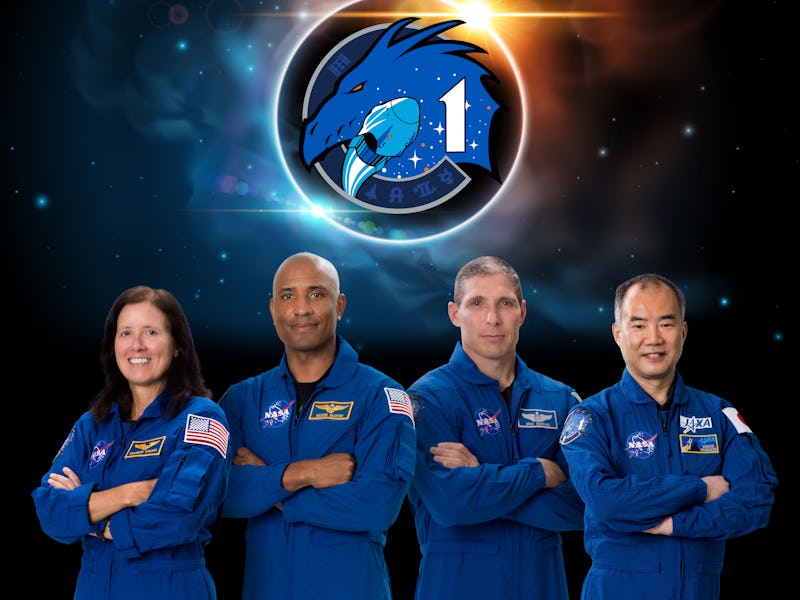Radishes and space suits: Here's what the ISS Expedition 64 astronauts will do in space
These four astronauts are about to get their hands busy.

On Sunday, four astronauts began their journey through space to the International Space Station, where they will be spending six months living and working onboard the orbiting laboratory.
SpaceX's human-carrying capsule successfully launched at 7:27 p.m. Eastern from Launch Complex 39A at the Kennedy Space Center in Florida, carrying NASA astronauts Michael Hopkins, Victor Glover, and Shannon Walker and Soichi Noguchi from the Japanese space agency JAXA.
The international crew of astronauts carried new science hardware and experiments along for the ride, and they will conduct hundreds of microgravity experiments onboard the space station during their stay.
Orbiting 250 miles above the Earth’s surface, the ISS is a laboratory like no other. Experiments onboard range from cultivating human organs to growing radishes in microgravity and testing out soccer balls.
And the newly launched ISS Expedition 64 is adding to the eclectic roster, bringing radishes, cool new space suits, and checking in on astronauts' hearts and brains.
Fresh new fit — Last year, NASA unveiled two new spacesuits designed for the upcoming crewed Artemis mission, scheduled to lift off for the Moon in 2024.
NASA unveiled new spacesuits that the upcoming Artemis crew will wear to the Moon.
The new suits, dubbed the Exploration Extravehicular Mobility Unit, provide added mobility, environmental control and life support system. They also use evaporation of water to maintain a relatively stable temperature for the astronauts and alleviate heat.
Astronauts onboard the space station won't get to don the new suit prototypes just yet, but the thermal control loop that controls the temperatures has been reconfigured into a single package to be tested in the Spacesuit Evaporation Rejection Flight Experiment on the station.
The experiment will simulate 25 eight-hour spacewalks, which is when astronauts venture outside the space station to do repairs or upgrades.
Space salad — Astronauts living in space are forced to survive on pre-packaged, frozen meals delivered to them from Earth. But as space agencies start to visualize long-duration missions to destinations millions of miles away, then a fresh source of food is more ideal.
The new members of the crew will tend to radish seeds that were launched aboard a Northrop Grumman resupply spacecraft, which will be planted in a small chamber with LED lighting onboard the station.
Space radishes are grown inside small chambers onboard the orbiting ISS.
Previous farming ventures on the station included growing red romaine lettuce, which astronauts first planted in May, 2014 as part of an experiment called Veg-01, where pillows of seeds were watered and cared for by crew members of Expedition 39.
The crops were left to grow for 33 days before being harvested and sent down to Earth to be analyzed and ensure they were safe to eat. In August, 2015, NASA’s Kennedy Space Center finally gave the okay for the astronauts onboard to enjoy the greens of their labor.
Hearts and minds — Human beings have been venturing out into space for more than 50 years, and yet the effects of spaceflight on the human body are still not fully understood.
NASA's Human Research Program relies on the astronauts onboard the space station for studies on how the human body adapts to time spent in a microgravity environment and whether the effects of being in space can cause permanent damage to human beings.
This research is crucial to humanity's future, as space agencies set their sights on missions to far out destinations like Mars.
During Expedition 64, investigations utilizing organ on a chip technology will include studies on muscle loss, lung function, and the blood brain barrier – all on devices the size of a USB flashdrive.
One of the experiments that will be conducted as part of Expedition 64 is showing the effect of a microgravity environment on heart cells and tissues by using engineered heart tissues. The tissues will be incubated and put under the microscope in space, and the samples will be collected at different times.
Another experiment on the human body is one designed by two students from Troy High School in Troy, Michigan, examining neural function onboard the ISS.
The experiment is designed to assess how spaceflight affects the human brain and the brain function, as well as come up with ways to mitigate those effects.